
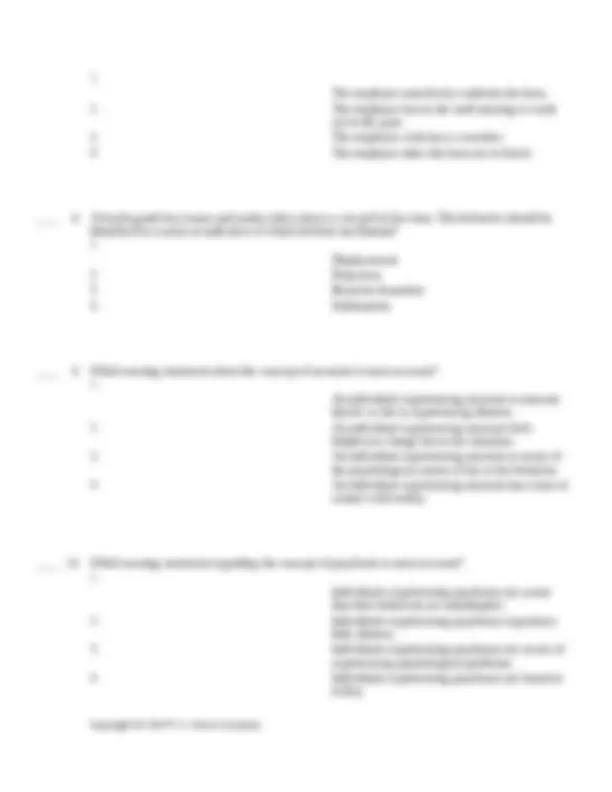
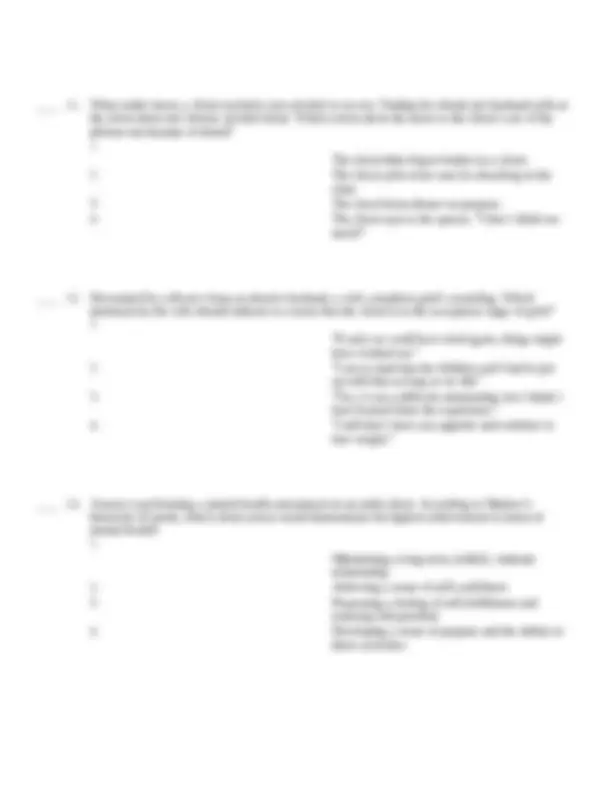
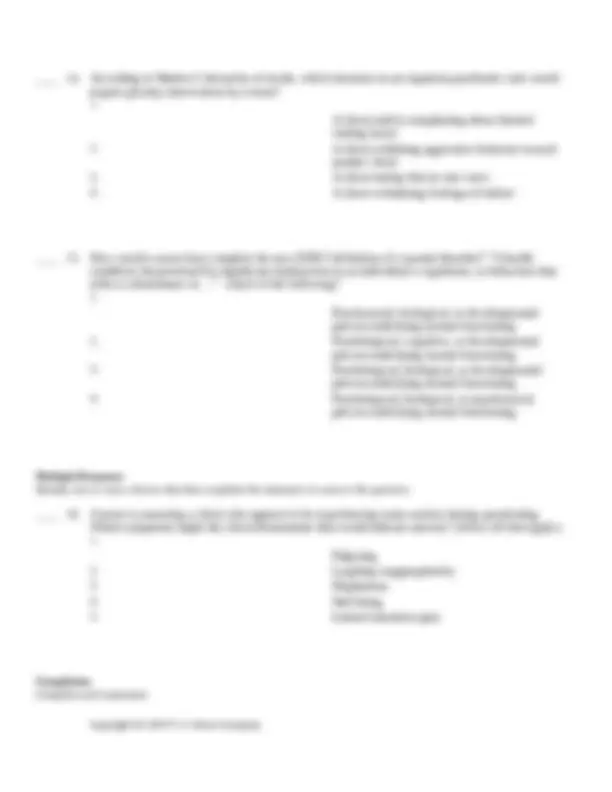
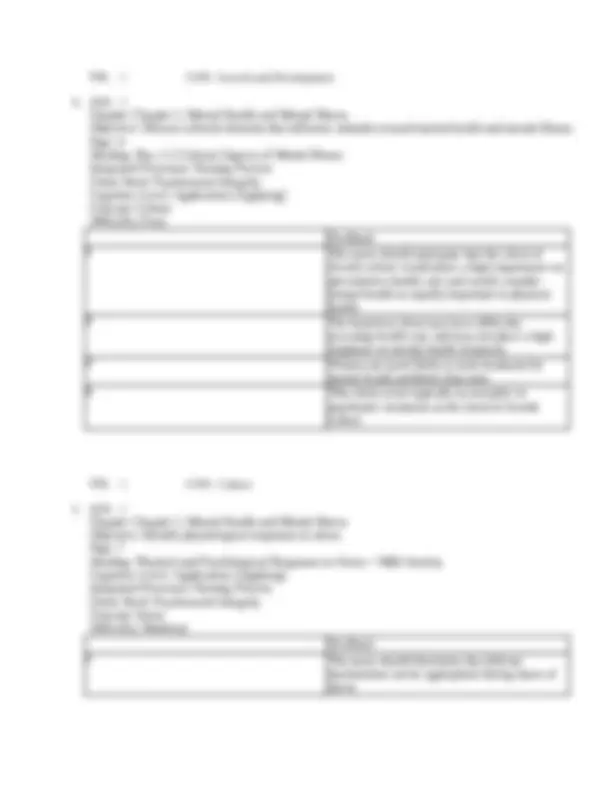
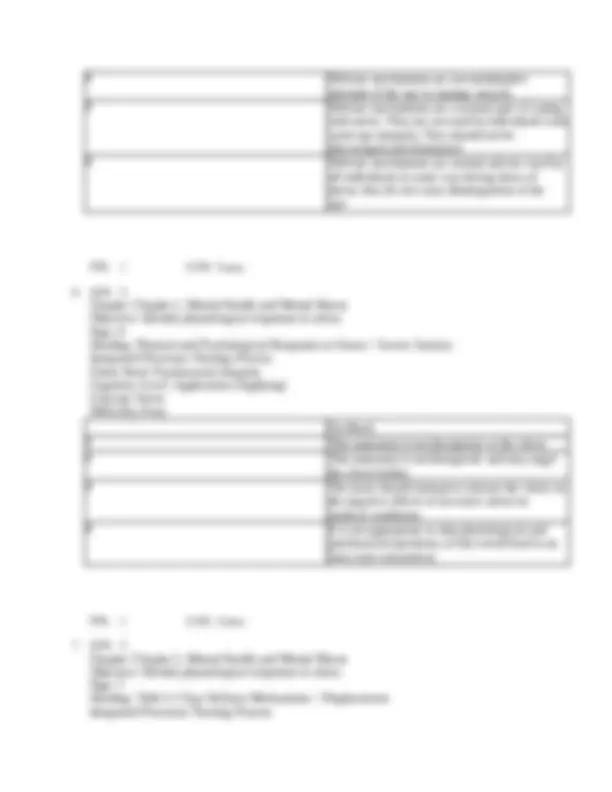
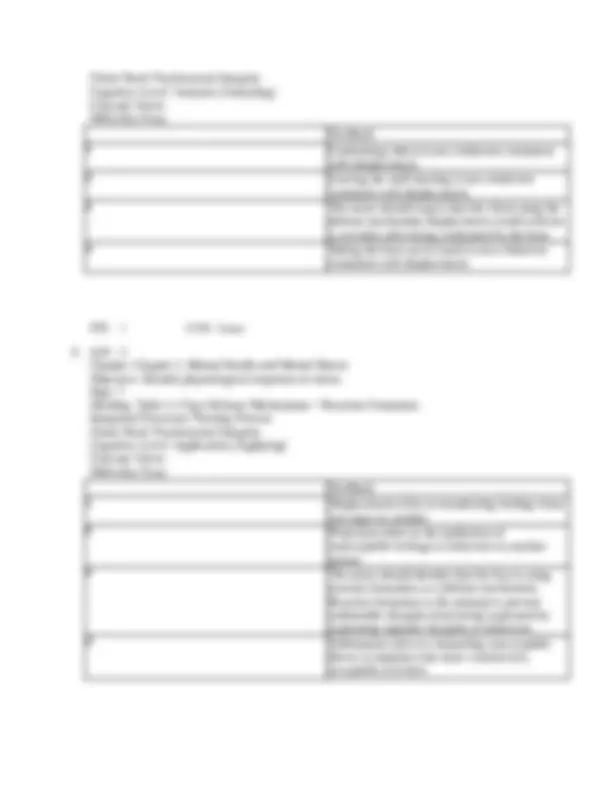
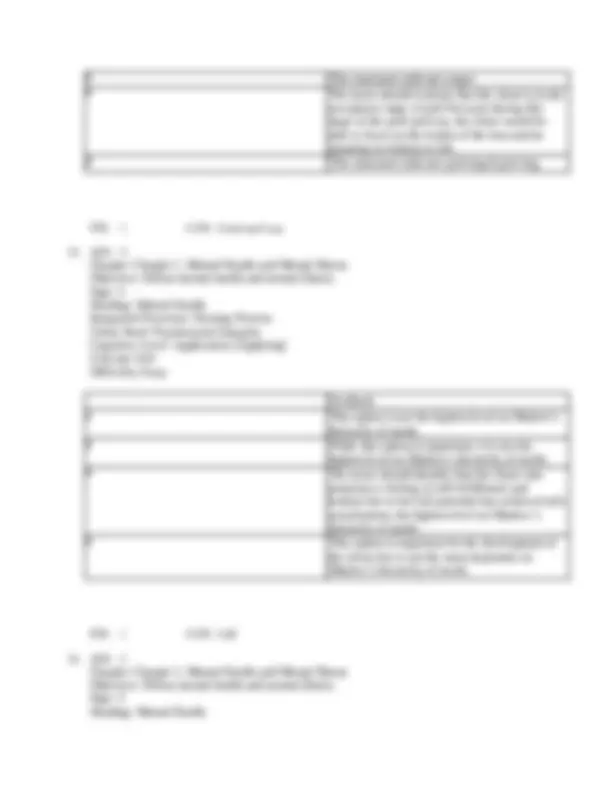
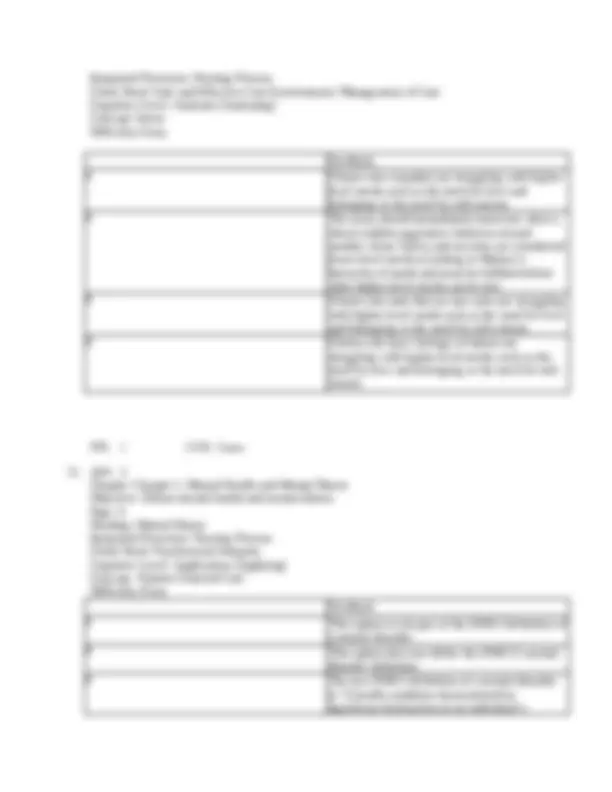
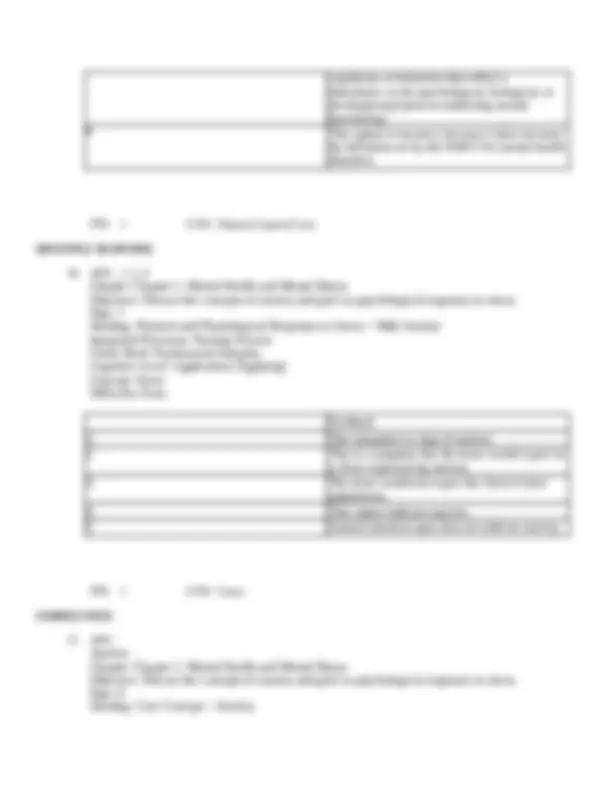


Study with the several resources on Docsity

Earn points by helping other students or get them with a premium plan


Prepare for your exams
Study with the several resources on Docsity

Earn points to download
Earn points by helping other students or get them with a premium plan
Community
Ask the community for help and clear up your study doubts
Discover the best universities in your country according to Docsity users
Free resources
Download our free guides on studying techniques, anxiety management strategies, and thesis advice from Docsity tutors
Chapter 1 questions from Lily Pharm
Typology: Exams
1 / 16

This page cannot be seen from the preview
Don't miss anything!










Multiple Choice Identify the choice that best completes the statement or answers the question.
____ 1. A nurse is assessing a client who is experiencing occasional feelings of sadness because of the recent death of a beloved pet. The client’s appetite, sleep patterns, and daily routine have not changed. How should the nurse interpret the client’s behaviors?
____ 2. At what point should the nurse determine that a client is at risk for developing a mental illness?
When thoughts, feelings, and behaviors are not reflective of the DSM-5 criteria.
____ 3. A nurse is assessing a set of 15-year-old identical twins who respond very differently to stress. One twin becomes anxious and irritable, and the other withdraws and cries. How should the nurse explain these different stress responses to the parents?
Reactions to stress are relative rather than absolute; individual responses to stress vary.
____ 4. Which client should the nurse anticipate to be most receptive to psychiatric treatment?
A Jewish, female social worker.
____ 5. A psychiatric nurse intern states, “This client’s use of defense mechanisms should be eliminated.”
Which is a correct evaluation of this nurse’s statement?
Defense mechanisms can be appropriate responses to stress and need not be eliminated.
____ 6. During an intake assessment, a nurse asks both physiological and psychosocial questions. The client angrily responds, “I’m here for my heart, not my head problems.” Which is the nurse’s best response?
“It is just a routine part of our assessment. All clients are asked these same questions.”
____ 7. An employee uses the defense mechanism of displacement when the boss openly disagrees with
suggestions. What behavior would be expected from this employee?
____ 11. When under stress, a client routinely uses alcohol to excess. Finding her drunk, her husband yells at the client about her chronic alcohol abuse. Which action alerts the nurse to the client’s use of the defense mechanism of denial?
The client hides liquor bottles in a closet.
____ 12. Devastated by a divorce from an abusive husband, a wife completes grief counseling. Which statement by the wife should indicate to a nurse that the client is in the acceptance stage of grief?
“If only we could have tried again, things might have worked out.”
____ 13. A nurse is performing a mental health assessment on an adult client. According to Maslow’s hierarchy of needs, which client action would demonstrate the highest achievement in terms of mental health?
Maintaining a long-term, faithful, intimate relationship
____ 14. According to Maslow’s hierarchy of needs, which situation on an inpatient psychiatric unit would
require priority intervention by a nurse?
A client rudely complaining about limited visiting hours
____ 15. How would a nurse best complete the new DSM-5 definition of a mental disorder? “A health condition characterized by significant dysfunction in an individual’s cognitions, or behaviors that reflect a disturbance in …” which of the following?
Psychosocial, biological, or developmental process underlying mental functioning
Multiple Response Identify one or more choices that best complete the statement or answer the question.
____ 16. A nurse is assessing a client who appears to be experiencing some anxiety during questioning. Which symptoms might the client demonstrate that would indicate anxiety? ( Select all that apply. )
Fidgeting
Completion Complete each statement.
Copyright © 2017 F. A. Davis Company
Feedback (^1) The client with a mental illness would have symptoms that reflect the DSM-. (^2) The nurse should determine that the client is at risk for mental illness when responses to stress are maladaptive and interfere with daily functioning. The DSM-5 indicates that in order to be diagnosed with a mental illness, daily functioning must be significantly impaired. (^3) The client’s ability to communicate distress would be considered a positive attribute. (^4) The use of defense mechanisms does not indicate that the client is at risk for mental illness.
PTS: 1 CON: Stress
Feedback (^1) The nurse should explain to the parents that, although the twins have identical DNA, there are several other factors that affect reactions to stress. (^2) It is considered normal for twins to react differently to stress. (^3) Identical twins do not necessarily respond similarly to stress, due to differences in temperament and personality. (^4) Environmental influences and temperament can affect stress reactions.
PTS: 1 CON: Growth and Development
PTS: 1 CON: Culture
Client Need: Psychosocial Integrity Cognitive Level: Analysis [Analyzing] Concept: Stress Difficulty: Easy Feedback (^1) Confronting others is not a behavior consistent with displacement. (^2) Leaving the staff meeting is not a behavior consistent with displacement. (^3) The nurse should expect that the client using the defense mechanism displacement would criticize a coworker after being confronted by the boss. (^4) Taking the boss out to lunch is not a behavior consistent with displacement.
PTS: 1 CON: Stress
PTS: 1 CON: Stress
PTS: 1 CON: Stress
Feedback (^1) The client with psychosis is unaware that his or her behavior is maladaptive. (^2) The nurse should understand that the client with psychosis experiences little distress owing to his or her lack of awareness of reality. (^3) The client with psychosis is unaware he or she has a psychological problem.
(^2) This statement indicates anger. (^3) The nurse should evaluate that the client is in the acceptance stage of grief because during this stage of the grief process, the client would be able to focus on the reality of the loss and its meaning in relation to life. (^4) This statement indicates prolonged grieving.
PTS: 1 CON: Grief and Loss
Feedback (^1) This option is not the highest level on Maslow’s hierarchy of needs. (^2) While this option is important, it is not the highest level on Maslow’s hierarchy of needs. (^3) The nurse should identify that the client who possesses a feeling of self-fulfillment and realizes his or her full potential has achieved self- actualization, the highest level on Maslow’s hierarchy of needs. (^4) This option is important for the development of the client, but is not the most important on Maslow’s hierarchy of needs.
PTS: 1 CON: Self
Integrated Processes: Nursing Process Client Need: Safe and Effective Care Environment: Management of Care Cognitive Level: Analysis [Analyzing] Concept: Stress Difficulty: Easy
Feedback (^1) Clients who complain are struggling with higher- level needs, such as the need for love and belonging or the need for self-esteem. (^2) The nurse should immediately intervene when a client exhibits aggressive behavior toward another client. Safety and security are considered lower-level needs according to Maslow’s hierarchy of needs and must be fulfilled before other higher-level needs can be met. (^3) Clients who state that no one cares are struggling with higher-level needs such as the need for love and belonging or the need for self-esteem. (^4) Clients who have feelings of failure are struggling with higher-level needs, such as the need for love and belonging or the need for self- esteem.
PTS: 1 CON: Stress
Integrated Processes: Teaching and Learning Client Need: Psychosocial Integrity Cognitive Level: Application [Applying] Concept: Stress Difficulty: Easy
Feedback: The definition of anxiety is a diffuse apprehension that is vague in nature and is associated with feelings of uncertainty and helplessness. Townsend considers this a core concept.
PTS: 1 CON: Stress
Feedback: The definition of grief is a subjective state of emotional, physical, and social responses to the loss of a valued entity. Townsend considers this a core concept.
PTS: 1 CON: Grief and Loss